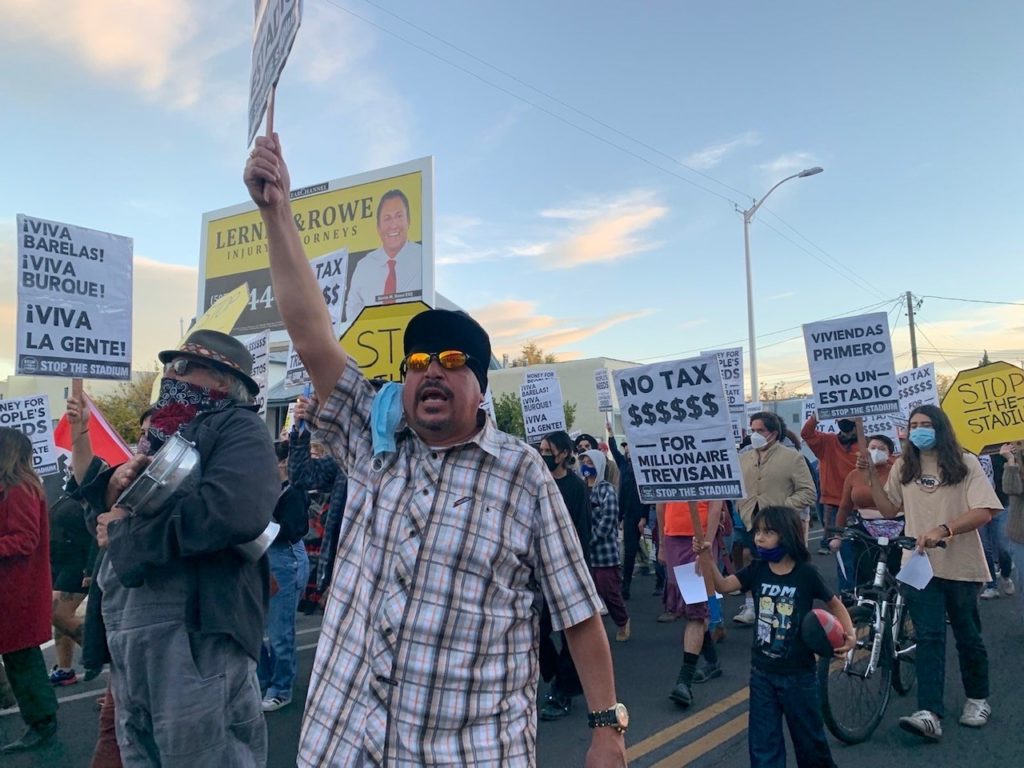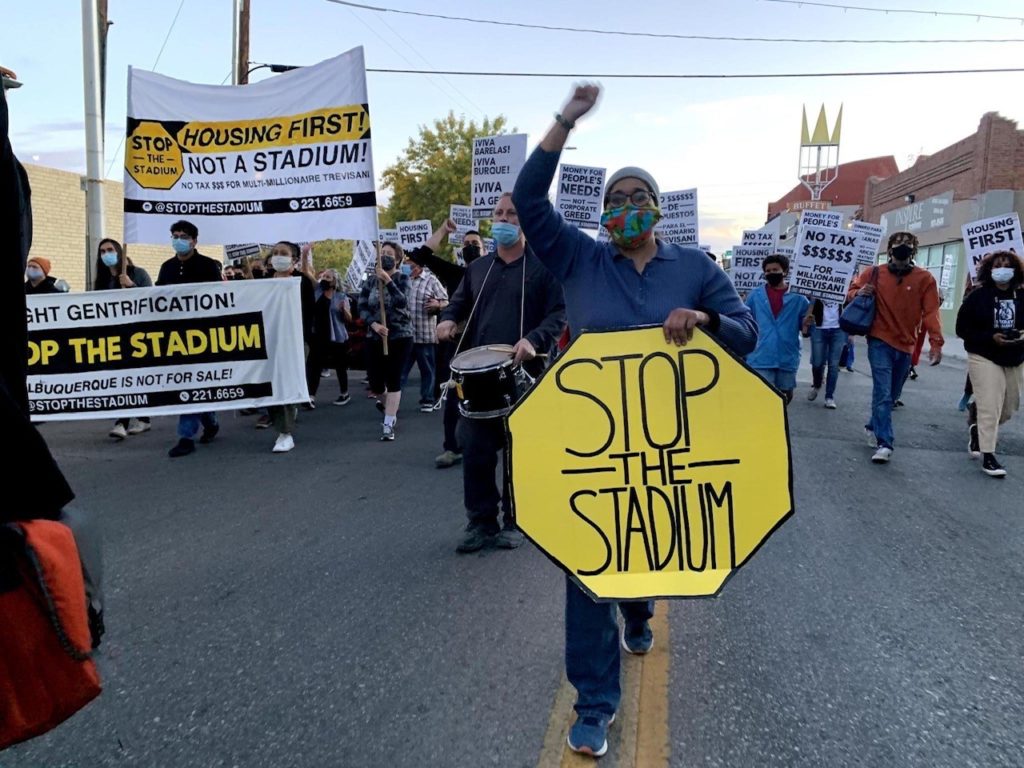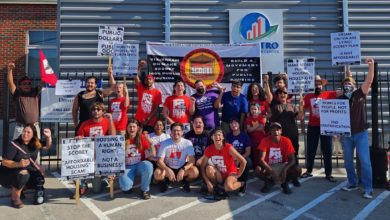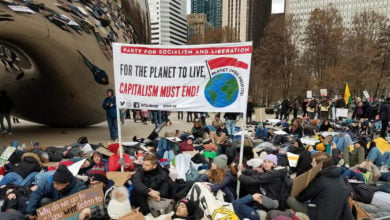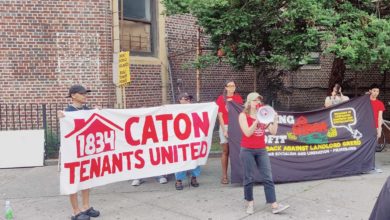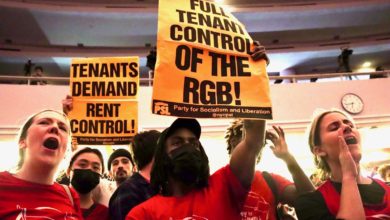During the election held in November, Albuquerque residents made history by defeating a major pro-gentrification measure. A $50 million corporate-backed stadium bond went down in flames at the polls by a margin of two to one.
The stadium’s corporate pushers were stunned. No bond measure had been voted down in Albuquerque since 2002, and only then by a slim margin. They assumed an easy victory. However, a powerful grassroots movement of volunteers and residents called Stop the Stadium rose up and changed the equation. Rank-and-file residents perceived this as a battle against gentrification and the destruction of Albuquerque’s historic working-class neighborhoods.
With no financial backing, Stop the Stadium pulled off a stunning David vs. Goliath upset, defeating the sports stadium corporate giants. A new Albuquerque housing movement has been born in the process.
Professional sports leagues operate as unregulated corporate monopolies. For decades, everyone up and down the sports industry food chain, including league executives, greedy developers, and local politicians have leveraged this position to funnel taxpayer money into subsidizing luxury stadiums so as to enrich this section of elites.
Whether publicly financed in whole or in part, everywhere stadiums are built they function as a massive force for gentrification and displacement.
Traditionally, major league monopolies set their sights on big cities with big markets. Today, however, with professional soccer on the rise and looking to expand into open space, stadium construction is targeting mid-sized cities. Professional soccer monopolies like Division II United Soccer League Championship (USL) are currently leading a stadium construction boom in mid-sized cities across the country.
The USL has built stadiums in ten different cities in the last five years, plundering taxpayer money to finance these projects and steamrolling all community opposition. Albuquerque was supposed to be next.
Earlier in the year, New Mexico United, a professional men’s soccer team affiliated with the USL, launched a multimillion-dollar marketing campaign to divert scarce public resources into building an $85 million soccer stadium. Team owner and mega-rich investment banker Peter Trevisani spent millions presenting false and misleading claims to Albuquerque residents in hopes that he could trick the public into passing a $50 million stadium bond on Nov. 2.
At every turn, Stop the Stadium was there to expose the sports stadium millionaires’ deceptive sales tactics and talking points. Here are some common ones that everyone should learn to spot.
The ‘People’s Stadium’ myth
The classic version of the big-stadium con job is to funnel vast amounts of taxpayer money into paying for privately-owned stadiums with all kinds of fake promises. As more and more working communities have come to reject this type of naked corporate subsidy, the millionaires are trying something new. They are building “people’s stadiums.”
In order to get around community opposition to paying for stadiums that corporate millionaires would own, team franchises are now negotiating deals where the city would own the facility instead of the private team. In Albuquerque, team ownership groups boasted that it would be a “people’s stadium.” There was a catch though. While “the people” would own the facility and all of the debt from the bond, the team would own and control all of the revenues.
That is what got proposed in Albuquerque. One hundred percent of the revenues from use of the stadium for any purpose would go to the private team, not the city. In return for getting to control and retain all the revenues from “the people’s’ stadium,” team owners would pay a small fraction back to the city as rent, an amount that would end up covering only a fraction of the bond debt that “the people” would be responsible for paying back.
The public was told that they will own the stadium and thus benefit, when in fact the team owners, through sleight of hand, were to own the revenues while the people owned the debt.
Myth: Publicly-funded stadiums create jobs and boost the local economy
Publicly financed stadiums for sports monopolies do not boost economic growth and do not help local residents or businesses. The average sports stadium has about the same impact on a community as one department store.
Elites and corporate developers claim that a stadium would serve as an economic boost to the local economy. According to them, the millions of dollars spent on a stadium would result in hundreds of jobs for struggling economies. However, faced with a monumental crisis of unemployment in the country, the per dollar impact of millions spent on publicly-funded stadiums is a farce.
The majority of jobs created by publicly-funded stadiums are temporary construction jobs. The remaining handful of jobs are seasonal and temporary concessions jobs that do not pay a living wage. This is a barely measurable impact on jobs. A recent study by George Mason University titled “Growth Effects of Sports Franchises, Stadiums, and Arenas: 15 Years Later” (2015), updated to include soccer franchises, reviewed data from 1969 to 2011. It found the economic impact of publicly-financed stadiums is generally so small as to be insignificant, and sometimes hurts growth. It found that although bringing sports monopolies to town is promoted as a major economic force, it usually accounts for less than 1.5 percent of the local economy.
Myth: A “Community Benefits Agreement” will protect communities
When big developers and local politicians need to quickly sell the public on a corporate project that is going to have bad effects on the community, their favorite tool is a “Community Benefit Agreement.” Rich developers and politicians handpick a few local organizations that they want to work with, call this group “the community,” and sign a CBA with them.
The hand-picked organizations are required to provide public political support, legitimizing the project, and in exchange corporate developers agree to some inadequate concessions to some of the neighborhoods facing displacement. These hand-picked organizations lose any ability to criticize the CBA and have to rely on the legal system for enforcement. CBAs contain a non-disparagement clause prohibiting the neighborhoods from publicly criticizing the project.
CBAs have been implemented by profit-hungry developers in city after city all across the country since the 1990s. Whatever short-term concessions get negotiated, CBAs never change the long-term destructive impact of pro-corporate development.
Myth: A stadium won’t cause gentrification
Sport franchises and local politicians always claim that the stadium will not cause gentrification. In reality, as a rule, they do.
It makes no difference if there is a “Community Benefits Agreement” in place or not. CBAs accept stadium-induced displacement as a fait accompli, and focus on reducing the damage.
Meanwhile, median rents drastically increase before, during and after stadium construction. A 2018 study titled “A Professional Sports Stadium’s Impact on Rental Values” documented that across 10 U.S. cities, median rent increased an average of $15 to $75 per year before construction, and an additional $40 to $50 per year after construction. Rent increased 10 miles in every direction.
Myth: Stadiums are about ‘quality of life‘
Stadium pushers always badger the public with claims that voting against the stadium is a vote against improving the “quality of life” of the working class, with an emphasis on the “intangible benefits” connected to being home to a professional sports team, like pride.
However, when it comes to tangible economic benefits that would actually improve the quality of life of existing residents and build pride — as easily affordable housing, rent control, free public transportation, and universal access to environmentally-sustainable, safe, clean, spacious and beautiful neighborhoods — the stadium pushers are on the other side. That’s because corporate stadium construction negates the above list of tangibles for the working majority.
Time and time again, stadiums have destroyed the social fabric of communities. In Nashville, Brooklyn, Chavez Ravine, Duranguito and many other cities, stadiums were used as a Trojan horse to accelerate gentrification and corporate-planned development.

